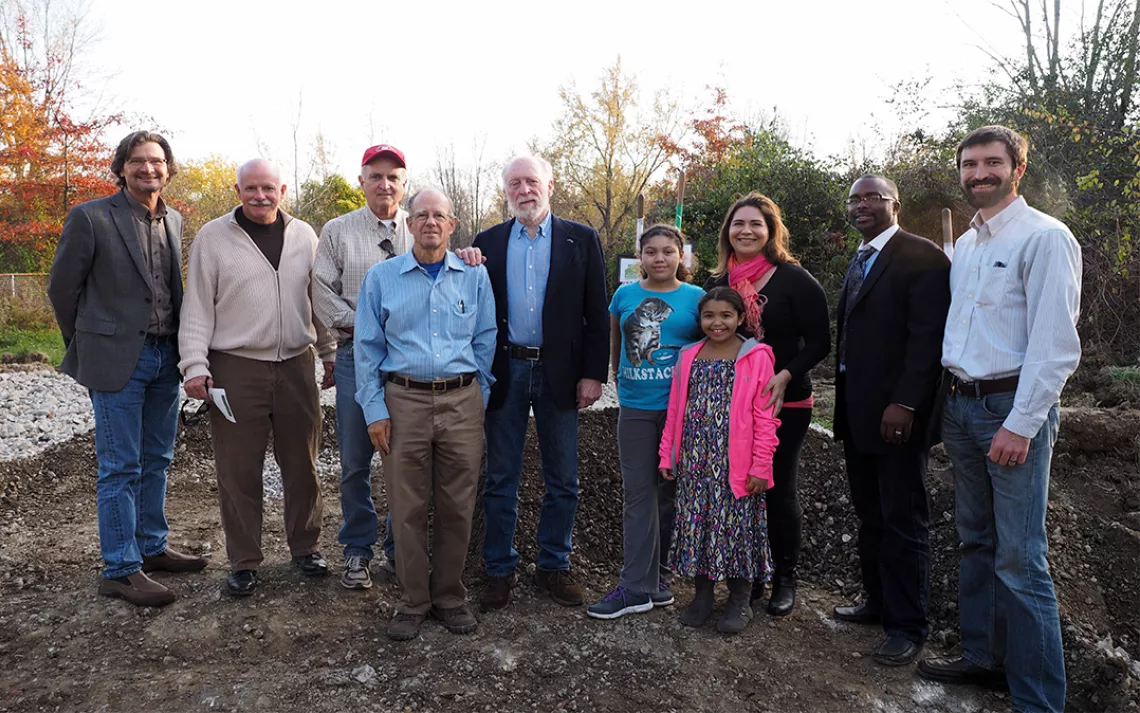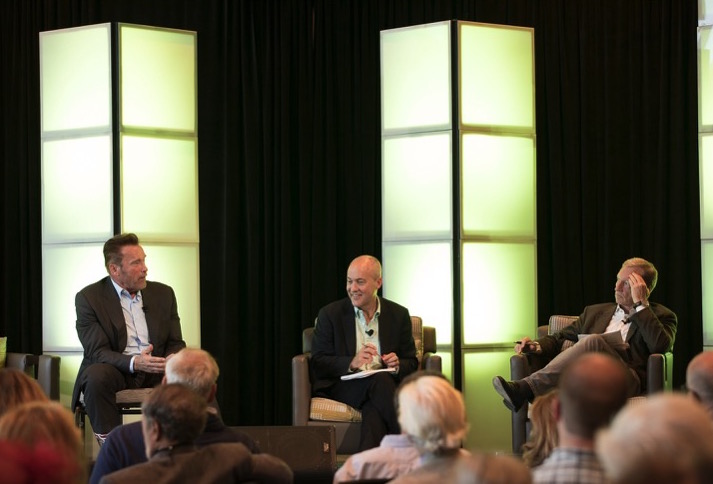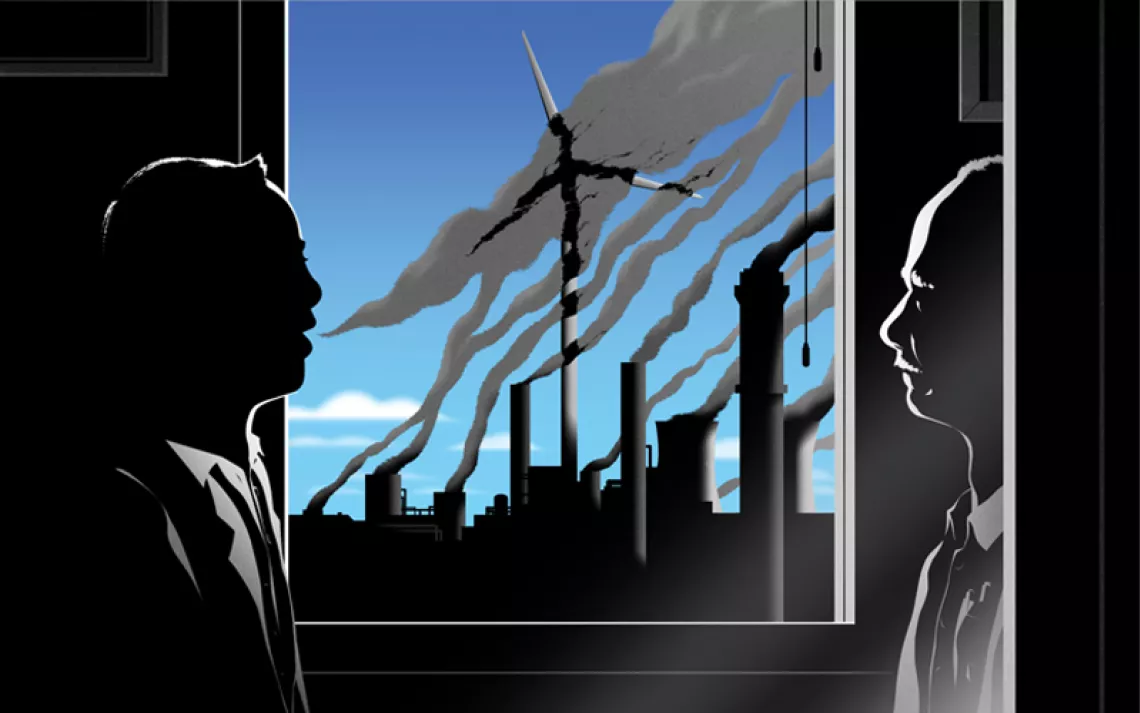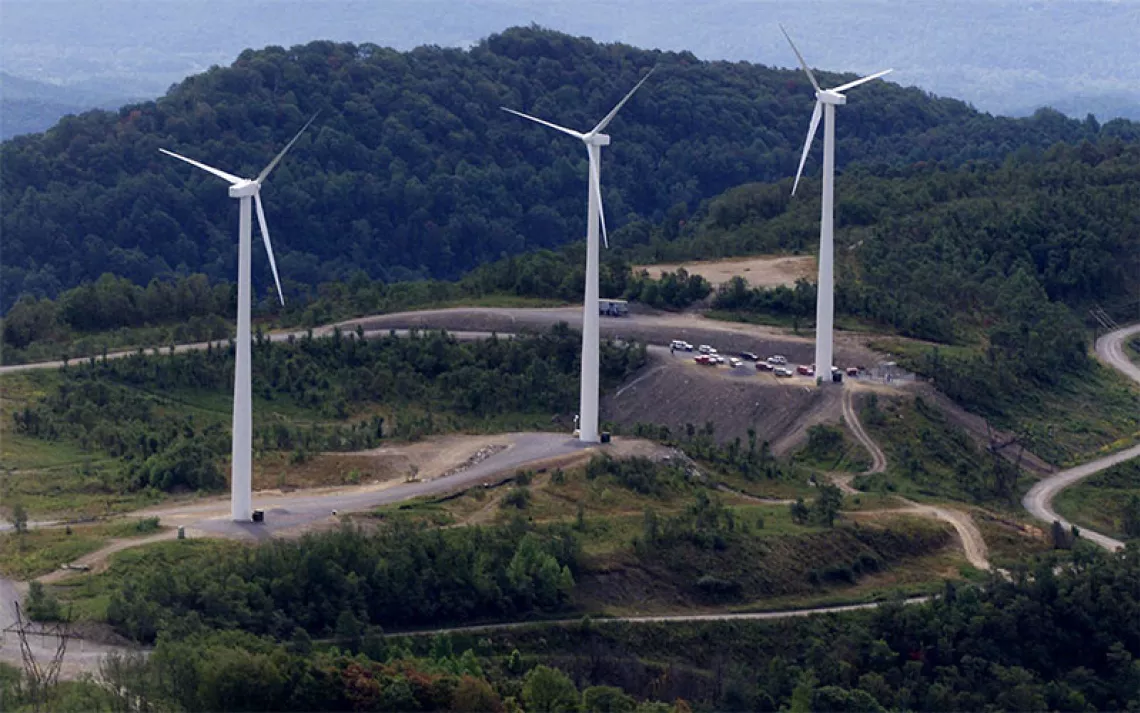The Oberlin Project Catalyzes a Green Economic Renaissance
In Oberlin, Ohio, an effort is underway to marry renewable energy with civic life

Zion CDC board members, the Mitchell family, and the construction committee at the Smith Street groundbreaking. From left to right: Joseph Ferut, Casey Gilfether, David Orr, Carl McDaniel, David Sonner, Danna Mitchell with daughters Nia and Jasmine, Alan Mitchell, and Sean Hayes. | Photo by Dale Preston
When Danna Mitchell heard about a new green-housing initiative to place a middle-to low-income family in an affordable, solar-powered home, she wasted no time throwing her name in the hat.
“I’ve always been an avid recycler,” she says. “I’m very concerned with the environment. And this town is very environmentally friendly. The schools have a dashboard, and they continually see where all the energy is going. So I’m always wanting to do the best I can for the environment, too.”
Mitchell lives in Oberlin, Ohio, which in recent years has quietly taken a leading role as a city working to prioritize greener, more energy-efficient solutions to food, housing, and economic growth. At the heart of Oberlin’s efforts is a Climate Action Plan the city council adopted in 2011 (updated in 2013), which set forth an ambitious agenda to decrease the use of fossil fuels, increase the efficiency of homes and businesses, and invest in green development.
Mitchell, a massage therapist and aesthetician at a local retirement home, is now part of that story. Hers was one of more than 20 families who applied in 2015 for a solar-powered home as part of the Zion Community Development Corporation’s (Zion CDC) Affordable Green Housing Initiative. After a lengthy application and review process, Zion CDC tapped Mitchell and her two daughters, Nia and Jasmine, and worked to help them qualify for a USDA Rural Development loan with favorable terms.
The initiative was made possible in part due to the leadership of the Oberlin Project, a grant-funded partnership between the City of Oberlin and Oberlin College, whose mission is to improve the sustainability and efficiency of the community. One of the project’s many collaborative ventures includes a joint effort with Zion CDC to invest in newly constructed, high-performance, solar-powered homes and make them available to middle-to low-income residents.
“One of the things that the Oberlin Project has been trying to provide is a living laboratory example of what cities can do independently to address climate change in terms of emissions, renewable energy, food, and agriculture,” says Sean Hayes, the executive director of the Oberlin Project, who operates between the project and the organizations with which it partners. “We are designed to be an example of what communities can build from the ground up.”
“Our community, being a small town in midwestern Ohio, has been challenged to have affordable housing,” says Alan Mitchell, the executive director of Zion CDC (no relation to Danna Mitchell), who played a strategic leadership role in making the Green Housing Initiative possible. “To overcome that by creating an affordable housing solution that is also sustainable is a good way to make sure that our community can live and thrive.”
Today, Danna Mitchell pays around the same amount per month for a 1,400-square-foot one-acre house on Smith Street that she used to pay in rent for a duplex. The house was built with a passive solar design, meaning that its materials and location help to store and distribute sunlight and heat; it also has active solar PV on the roof, installed at no upfront cost by Solar Action, LLC. It features advanced insulation, high-performance appliances, and a tankless water heater. A monitoring system lets Mitchell and her kids track how much energy they are consuming in real time.
The original design for the house came from college student Lydia Karoscik. In the fall semester in 2013, Zion CDC approached Joseph Ferut, an assistant professor in the College of Architecture and Environmental Design at Kent State University, about the possibility of building an affordable green home as a pilot project that would be replicable in other communities. The class took up the challenge, and Karoscik’s design won the day. Zion CDC then tweaked and improved the design; the Oberlin Project worked among the various parties to facilitate its financing and construction; and housing specialist and project manager Casey Gilfether played the day-to-day role in getting the house built and making sure it came as close to budget as possible.
Karoscik named the house “An Grianán,” Irish for “sunny place,” to mark its solar design.
“Building a house that runs on sunshine is off-the-shelf technology,” says Carl McDaniel, visiting professor of environmental studies at Oberlin College, who provided expertise for the project based on his own experience building a similar home. “Anybody can do it.”
Zion CDC was founded and incorporated by Rev. Dr. Fred L. Steen (1929–1998), the senior pastor for nearly 50 years at Oberlin’s Mount Zion Baptist Church, whose civic advocacy included efforts to fight housing discrimination locally and nationwide. He was a close friend and collaborator of Dr. Martin Luther King Jr.
“To be able to see Dr. Steen’s dream come together in this way—affordable housing for people—is especially meaningful for me, having been christened and baptized by him when I was a young man,” Alan Mitchell says.
*
It’s been over a year since Danna Mitchell moved in to An Grianán on Smith Street. The house, Zion CDC recently reported, used 79 percent less energy over 12 months than the average home in Oberlin. Construction is now underway on a second house, a rehab of an existing building, with another lucky family waiting to take occupancy some time after February.
This is one of several sustainable efforts happening in this small town of just under 10,000, many of which were made possible by the Oberlin Project—a vanguard civic initiative catalyzing efforts here to phase out dirty sources of energy and work toward a greener, more energy-efficient infrastructure and economy.
The project was the brainchild of David Orr, a professor of environmental studies and politics at Oberlin College. He’s the author of several books, most recently Dangerous Years: Climate Change, the Long Emergency, and the Way Forward (Yale University, November 2016). In the late 1980s, he organized a series of studies on energy efficiency and water use on several college campuses. In the 1990s, he led an effort to reinvent the built environment with the Adam Joseph Lewis Center, Oberlin’s environmental studies building.
“We set out to create an entirely solar-powered, zero-discharge building on campus—effectively the first substantially green building in higher education,” Orr says. “It gave students and faculty and other people who came to see it a model of how we might build similar community structures.” The building, which opened in 2000, provides all of its own energy, plus a 45 percent surplus—essentially a Platinum-rated building before the rating system existed.
Orr was preparing to leave his position at Oberlin when, in 2007, incoming president Marvin Krislov began a series of conversations with him about how the college could use its buying and investing power—and institutional clout—to develop a model of sustainability for the city. In 2009, the Oberlin Project was born.
“The concept of the project was focused around a handful of goals that were meant to represent what we call full-spectrum sustainability at the community level,” says Sean Hayes. “Those are things like powering a community without greenhouse gases; growing a much higher percentage of our foods locally; preserving land and agriculture; educating for sustainability; rethinking a post-carbon economy. That’s the genesis of the Oberlin Project.”
In 2010, the project received a boost when the City of Oberlin and Oberlin College joined the Clinton Climate Initiative’s Climate Positive Development Program. As part of the agreement, Oberlin College set a carbon-neutrality climate positive date of 2025, and Oberlin city set a date of 2050.
“As renewables pick up, and more and more cities are taking on these challenges, we’re seeing those dates shift closer to the present, both because of the urgency of the climate situation, and also because there are solutions out there now that work,” Hayes says.
“What the Oberlin Project did was give us a narrative, a big picture, in which we were able to fold the community's work on agriculture issues and energy issues and housing and economic development,” Orr says. “That has been the background story for the revitalization of this little town.”
 From left to right: Arnold Schwarzenegger, Michael Duffy (Time magazine), and Tom Steyer at the After Fossil Fuels conference in Oberlin. | Photo courtesy of David Orr. Most recently, the Oberlin Project facilitated the funding and construction of a hotel and conference center, the Hotel at Oberlin, which just opened downtown this past October. Oberlin College owns the hotel, which is one of only five in the United States built to LEED Platinum standards. It’s powered entirely by a dedicated portion of an offsite solar array and is the first hotel in the nation to incorporate solar, ground sourced heat pumps, and radiant heating and cooling. The conference center’s maiden event since opening was the aptly themed “After Fossil Fuels: The Next Economy” (October 6-8), featuring 43 luminary speakers and panelists, including Michael Brune, Richard Heinberg, Arnold Schwarzenegger, Tom Steyer, Hunter Lovins, and Mark Campanelli.
From left to right: Arnold Schwarzenegger, Michael Duffy (Time magazine), and Tom Steyer at the After Fossil Fuels conference in Oberlin. | Photo courtesy of David Orr. Most recently, the Oberlin Project facilitated the funding and construction of a hotel and conference center, the Hotel at Oberlin, which just opened downtown this past October. Oberlin College owns the hotel, which is one of only five in the United States built to LEED Platinum standards. It’s powered entirely by a dedicated portion of an offsite solar array and is the first hotel in the nation to incorporate solar, ground sourced heat pumps, and radiant heating and cooling. The conference center’s maiden event since opening was the aptly themed “After Fossil Fuels: The Next Economy” (October 6-8), featuring 43 luminary speakers and panelists, including Michael Brune, Richard Heinberg, Arnold Schwarzenegger, Tom Steyer, Hunter Lovins, and Mark Campanelli.
Orr says that the project’s mission is to move both the city and the college into operational climate-neutral planning and let that drive a local economic renaissance.
“Our goal is to take those things that make up the core issues of sustainability—food, energy, and shelter—and build those into the economy as a series of business enterprises,” says Orr. One example is the Lorain County Solar Cooperative, which the project organized in collaboration with the Community Power Network and Ohio Sun to help residents and homeowners buy into a bulk purchase of solar arrays for their homes. It is the first community solar cooperative initiative in the state of Ohio.
The project’s educational goal is to build sustainability initiatives and research projects into the curriculum at Oberlin College and even the local public school. That curriculum includes keying students in to the city’s real-time resource flow monitoring dashboard so that they can track energy and water consumption.
In its work on food and agriculture, the project organized the Oberlin Food Hub with the goal of developing the infrastructure of farm capacity to provide up to 70 percent of the city’s food from local farmers.
The Oberlin Project was originally intended to last for about a decade. The idea is that it serves not to own any of the initiatives it ultimately helps make possible, but to catalyze them, and pay them forward—such as in the case of Danna Mitchell’s house on Smith Street.
“It’s a dream come true,” Mitchell says. “I never thought I could afford a house, let alone a house that was energy efficient and had solar.” It’s also important to her that her kids can live and breathe the importance of protecting the environment. “They are the future. If we don’t teach them to help the environment, they aren’t going to have a future.”
 The Magazine of The Sierra Club
The Magazine of The Sierra Club







